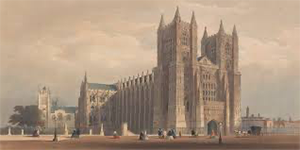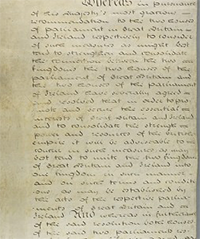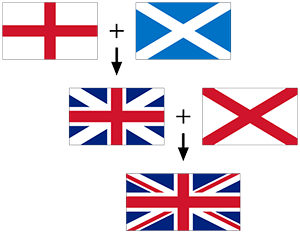Creating the United Kingdom: The Act of Union 1800
The Act of Union 1800 created the United Kingdom, a melding of the countries of Ireland, England, and Scotland. 
English monarchs had been claiming sovereignty over Ireland as early as Henry II in 1171. Henry named his young son John Lord of Ireland in 1185; John kept this title when he became King of England in 1199. A break of sorts between England and Ireland occurred in 1532, when King Henry VIII stepped away from the Catholic Church and named himself the head of the Church of England. Ireland stayed Catholic. English monarchs set about policing Ireland by installing a number of plantation owners there and by passing Penal Laws that effectively declared the Anglican Church of Ireland the proper faith. In the months leading up to the English Civil Wars, many in Ireland rose in rebellion, in effect declaring their support for King Charles I. In the wake of the capture and execution of that king, Ireland formed its own independent government, called Confederate Ireland. Oliver Cromwell, who emerged with the most power after the end of the Civil Wars, led a large army into Ireland and brought it back into the fold, at great cost of life and money on both sides. Beginning with Charles II, a succession of monarchs either became (in Charles's case) or were Catholic (as was the case with James II. The birth of James's son, who soon became a Catholic, sparked the Glorious Revolution, resulting in the reign of the Protestants William and Mary. Laws continued to protect the throne from Catholic rulers and to proscribe the Church of England as effectively the state religion. At the same, laws prohibited anyone who was Catholic from assuming the throne or even holding political office. This extended to the Irish Parliament, even though Ireland was overwhelmingly a Catholic country. 
The Act of Union 1707 created the Kingdom of Great Britain. Thus were Scotland and England merged, while Ireland was not. In 1798, a large number of people in Ireland, gaining inspiration from successful revolutions in American and France, revolted against British rule, seeking to set up an independent republic. A prime motivation for many of those in rebellion were a desire for Catholics to have more power and opportunities. One of the leaders of the Irish revolt was Theobald Wolfe Tone, who had some success in fighting against the British military response to the rebellion. However, the Royal Army and Royal Navy were very successful in putting down the Irish rebellion, and Tone was one of those executed in the aftermath of the fighting. Britain responded politically as well, abolishing the Irish Parliament and pursuing a course of consolidation. Pitt oversaw the Act of Union, which added Ireland to the fold and created the United Kingdom. Pitt also wanted to see enacted Catholic emancipation, which would have allowed members of the Catholic faith to hold political office. (They had been denied such for many decades.) The king was happy to be the monarch of the United Kingdom but flatly refused to endorse the Catholic proposal. In frustration, Prime Minister William Pitt the Younger resigned as Prime Minister. 
A flag to honor the new kingdom included elements of all the countries. The Grand Union of England and Scotland in 1606 had produced the Union flag. The addition of Ireland's flag created the United Kingdom flag. As with the Act of Union 1707, the United Kingdom had one Parliament. (The Irish Parliament was dissolved.) Ireland sent 100 members to the House of Commons and 32 members to the House of Lords. The Act of Union 1800 nominally included a provision for Catholic Emancipation, the removal of restrictions on people professing the faith. The king, King George III, refused to give his Royal Assent to the matter, however, and the idea of Catholic Emancipation was dropped. |
|
Social Studies for Kids
copyright 2002–2026
David White




